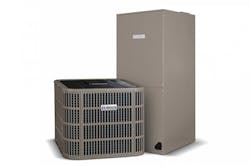Air-Source Heat Pumps in Cold Weather
By Michael Tobias
Heat pumps are emerging as an efficient solution for space heating and air conditioning, especially when used in variable refrigerant flow systems. They can match the most efficient air conditioning systems in cooling mode, and can compete with the low cost of combustion heating while using only electricity. Compared with a conventional resistance heater, a heat pump achieves savings in the range of 40 to 80 percent, depending on the specific model and operating conditions.
While air-source heat pumps exchange heat directly with outdoor air, ground-source heat pumps take advantage of the stable underground temperature to achieve a higher efficiency. Considering the high price and complex installations of a ground-source system, air-source heat pumps are the most common option.
The main limitation of air-source heat pumps is a significant drop in performance when outdoor temperatures reach the freezing range. Design engineers must consider the effect of local weather when specifying a heat pump, and ensure the system is equipped with adequate measures for the lowest temperatures expected.
How Does the Extreme Cold Affect Air-Source Heat Pumps?
The main challenge when using an air-source heat pump with freezing temperatures is controlling ice accumulation on the outdoor coils. Since the unit is removing heat from outdoor air that is already cold, humidity can easily collect and freeze on the surface of its coils.
Although the heat pump defrost cycle can melt ice on the outdoor coils, the unit cannot deliver space heating while the cycle lasts. As outdoor temperatures drop, the heat pump must enter the defrost cycle more frequently to compensate for ice formation, and this limits the heat delivered to indoor spaces.
Since ground-source heat pumps do not exchange heat with outdoor air, they are relatively unaffected by freezing temperatures. However, they require excavations that can be difficult to perform under existing buildings, especially those in crowded urban areas.
Specifying Air-Source Heat Pumps for Cold Weather
When using air-source heat pumps with freezing temperatures, there are two main ways to compensate for the heating loss during defrost cycles:
- Adding a backup heating system, typically a gas burner or electric resistance heater.
- Specifying a heat pump with built-in measures against frost accumulation.
Backup heating systems for air-source heat pumps are a simple solution, but they tend to increase the system ownership cost. The design considerations change depending on the type of backup heating specified:
- An electric resistance heater runs with the same energy source as the heat pump. However, it draws more current for a given heating load, requiring an increased wiring capacity. The overall system efficiency also drops, since resistance heating is much less efficient than heat pump operation.
- A gas burner achieves a much lower operating cost than a resistance heater. However, it requires a gas supply and an exhaust system, driving up the cost of the installation.
When a heat pump system uses backup heating, a recommended practice is setting the thermostat at a moderate temperature. This minimizes the frequency of the defrost cycle and the operating time of the backup heating system, lowering total energy consumption.
Heat Pumps with Built-In Measures Against Cold Weather
Air-source heat pumps from leading manufacturers are typically rated for outdoor temperatures as low as -4°F. However, when the units are enhanced with cold weather measures, their operating range can extend below -10°F or even -20°F. The following are some common design features used by heat pump manufacturers to mitigate the impact of the defrost cycle:
- Some manufacturers include heat accumulators, which can continue delivering heat when the heat pump enters the defrost cycle.
- There are also heat pump configurations where one of the hot refrigerant lines circulates through the outdoor unit to help prevent freezing. The defrost cycle only activates when this heating effect is not enough.
- When a heat pump system uses multiple outdoor units, they can be programmed to enter the defrost cycle in a sequence and not simultaneously. This way, the system never loses its full heating capacity due to defrosting.
- Outdoor units can also be equipped with housings that protect the unit from direct snowfall. This way, the unit must only deal with the ice that forms directly on the coils.
While these measures do not eliminate the defrost cycle completely, they can reduce its impact on the heating output. To achieve the best results with an air-source heat pump system, the first recommended step is an assessment of the local weather. This way, an adequate system can be specified from the start; which is simpler and less expensive that upgrading an unsuitable installation.
Complementary Measures to Enhance Heat Pump Efficiency
Having an energy-efficient heat pump system reduces heating and cooling expenses. However, the building itself can also be designed to minimize cooling needs during summer and heating needs during winter. A building envelope with adequate insulation and airtightness minimizes the need for heating and cooling, compared with a building with poor insulation and many air leaks.
Ventilation controls also contribute to heating and cooling efficiency, by adjusting airflow according to the needs of the building. When ventilation systems operate at full airflow all the time, the air volume that must be conditioned is higher. On the other hand, if ventilation is adjusted according to occupancy, the total air volume that must be conditioned is lower.
There is a wide range of heating and cooling configurations that can be deployed in buildings. However, the lowest ownership cost is achieved when the installation is optimized according to the building’s needs.
Michael Tobias is the founder and principal of New York Engineers, an Inc 5000 Fastest Growing Company in America. He leads a team of 30+ mechanical, electrical, plumbing, and fire protection engineers from the company headquarters in New York City; and has led over 1,000 projects in New York, New Jersey, Pennsylvania, Connecticut, Florida, Maryland and California, as well as Singapore and Malaysia.
